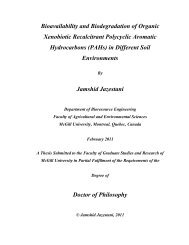i THERMAL PROCESSING EFFECTS ON TOTAL ... - McGill University
i THERMAL PROCESSING EFFECTS ON TOTAL ... - McGill University
i THERMAL PROCESSING EFFECTS ON TOTAL ... - McGill University
Create successful ePaper yourself
Turn your PDF publications into a flip-book with our unique Google optimized e-Paper software.
2.1 The Lentils<br />
Lentils (Lens culnaris Medikus), a cool season food legume and one of the<br />
world‘s oldest cultivated crops, plays an important role in the diets of many cultures.<br />
Lentils are consumed daily by many inhabitants of the Middle East and Asia (Yadav et al.,<br />
2007). Lentils are an important commercial crop grown in Canada, with large areas in<br />
Saskatchewan being devoted to their culture (Saskatchewan Pulse Growers, 2007).<br />
Canada‘s production of lentils reached 1.04 Tg yr -1 in 2002, and its exports accounted for<br />
44 % of total international lentil exports (Agriculture and Agri- food Canada, 2002c).<br />
Lentil is annual bushy herb with erect, spreading and compact growth habit. Its stems are<br />
slender, angular, light green in color, and the plants are 0.15-0.75 m in height. The seeds<br />
are round, small, lens shaped and weigh between 2-8g per 100 seeds (Duke 1981,<br />
Muehlbauer et al., 1985).<br />
Although the lentils consumption is relatively low in western countries, the<br />
production and consumption per capita has increased over the last few years. Lentil seeds<br />
are used in various cuisines worldwide, and lentil flour can be used in soups, stews and<br />
purees, as well as mixed with cereals to make breads, cakes and food for infants (William<br />
and Singh, 1988) which provide essential amino acids which are deficient in cereal grains.<br />
Further, lentil flour also has a potential for traditional and newer product developments<br />
with various health benefits since it contain large amount of protein, and is gluten-free<br />
and low in glycemic index (Swanson, 1990).<br />
Lentil varieties differ on the basis of their seed coat, cotyledon colour, seed size,<br />
plant hairiness, and leaf colour (Yadhav et al., 2007). Two main varieties of lentils are<br />
grown in Canada, red and green. Red-colored lentils, which have brown or grey seed<br />
coats and orange to red cotyledons, are mainly consumed hulled, whereas green lentils,<br />
with light green seed coats and yellow cotyledon, are consumed whole.<br />
2.2 Chemical Composition of Lentils:<br />
The chemical composition of lentil-like food legumes is governed by the species,<br />
cultivar, geographic location and growth conditions. Lentil seeds‘ main components<br />
8









